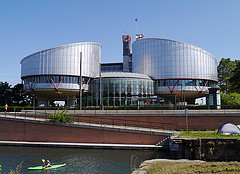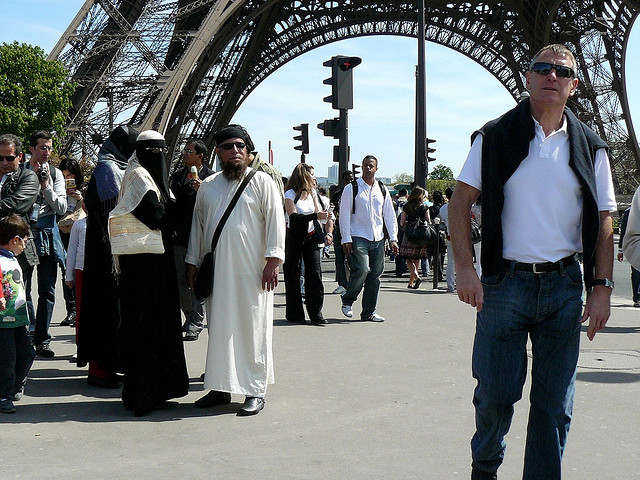The ECHR’s upholding of the French face-veil ban sets a very worrying precedent for the freedom of religious expression
The former President of the French Republic, Nicolas Sarkozy, instituted a ban on covering one’s face in a public area. It was interpreted as targeting the Muslim community, and since its implementation has had the biggest impact there. The case was challenged, and eventually upheld by the European Court of Human Rights. Daniel Barton argues that the ease with which the French Government got around the relevant human rights limitations should worry us all.
Is there any persuasive justification for a general face-veil ban?
Soon after Nicolas Sarkozy won the presidential elections in 2007, the French government launched a public debate on what it means to be French, with a campaign organised around the theme of “national identity”. During the debate, the wearing of face-veils by some Muslim women was identified as a practice contrary to core French values. In an effort to woo more voters to its camp, the government then decided to ban burkas and niqabs entirely from the French public sphere. However, had they banned a religious symbol directly, this could have been challenged very easily before the courts as contrary to religious freedom. To ensure the law appeared to be non-religious and neutral, they instead proposed a complete ban on concealing one’s face in public (although they made exceptions for headgear that is traditionally present in France, such as motorcycle helmets and carnival masks).
That controversial law was approved by the French parliament in 2010, and became applicable on 11 April 2011. In practice, the law makes it illegal to appear in public with one’s face fully covered, and anyone doing so can face a fine of up to 150 euros, or may be required to take a citizenship course. Despite not applying exclusively to religious veiling, those most affected are the few women who cover their faces in public for religious or cultural reasons and it was one of these women who was the first to challenge the law before the European court of Human Rights (hereinafter the Court). However, the law successfully passed the scrutiny of the Grand Chamber of the Court on 1 July 2014 (S.A.S. v. France).
So how has the first law of its kind – imposing a general ban on covering one’s face – succeeded in being approved both by the French legislators and by the European Court of Human Rights as necessary and proportional? Were the arguments used reasonable, and how easily could they be transferred to other national contexts? And what impact could this have on the way British politicians talk about minorities and about “non-British” practices?
What arguments did the French use and what could our reaction be?
The French way of managing relations between religions, state and society, is bound up in the concept of laïcité. However, laïcité was not among the core legal justifications of the ban either in France, or before the Court, because despite being treated as a French national mantra when it comes to questions related to religion, the principle of laïcité can only apply to public institutions, and not to individuals – individuals are free to manifest their convictions as long as they respect others and public order.
Public security, safety and order were therefore a major focus in the debates leading up to the introduction of the ban. Both politicians and the media expressed fear about what could hide under veils and other loose garments. How do we know if it is really a woman? Are they carrying weapons? How do we identify a veiled phantom who robs a bank, or wants to collect a child from school?
It is of course understandable, and a common feature of anti-terrorism discourse, that people fear things they do not know, and would like to prevent them from being seen. However, such fear cannot be an outright reason for banning all forms of mystery, and preventative logic should not take over when there is no evidence that any of the feared dangers are likely to materialise (the French government did not offer any evidence). Moreover, if there are less restrictive measures available, they should be considered first. In this case, for example, it was possible to envisage a legal obligation to unveil when requested to do so by a policewoman or female teacher for the purpose of an identity check, or an obligation not to cover one’s face in banks and places of that sort.
This line of reasoning was adopted by the French Conseil d’Etat inthe study in which it advised the French government not to adopt a general ban but to allow local authorities to introduce local bans that would be tailored to actual problems with face concealment. The French government considered that option “insufficient” (for their political goals).
They next turned to the principle of respecting others and their rights, which has provided a number of arguments in favour of the ban. The first concerned the protection of women and children from forced face-veiling, and would have been very persuasive if French criminal law had not already provided sufficient sanctions for people who engage in such activities. A second group whose protection was called for were moderate Muslims, who could eventually yield to peer pressure from more religiously devout persons. Although this could be seen as a valid concern in French society, it would have been rather tricky to justify a general face-veil ban for this purpose, because such outright bans often lead to greater radicalisation of the moderate (as shown by Unveiling the Truth, a study by the Open Societies Foundations) and because there was very little evidence that women had decided to wear the burka or niqab after encountering radicals (indeed, the same study found the very opposite).
Two more significant arguments came into play, which can be treated as part of respect for the rights and freedoms of others, or separately, depending on how broadly they are construed: these arguments are based on the concepts of gender equality and human dignity.
Face-veiling was seen to challenge gender equality in various ways. Some saw the veil as separating men and women, others interpreted it as a symbol of the objectification of women, as a means of making women disappear from the public space, or simply as another imposition by a paternalistic society. All of these observations merited some attention by the policy makers. However, they cannot be used as a justification for prohibiting women from wearing what they want to: such a prohibition would itself hardly be reconcilable with the principles of gender equality, and moreover there is no evidence that such a ban would liberate oppressed Muslim women. Indeed, the case studies made to date (Unveiling the Truth and After the Ban by the Open Societies Foundations and Wearing the Face Veil in Belgium by the Human Rights Centre of Ghent University) have shown that the ban forces many women to stay at home more than they would have before, and be less integrated into their local society.
The same tension between paternalism and freedom came up in discussions about human dignity. The French parliamentarians and jurists involved in a ssessing the face-veiling ban noted that such a ban is only conceivable in the context of a paternalistic understanding of human dignity, which affords society the right and responsibility to correct its ill-thinking members. This paternalistic logic could justify preventing veiled women from violating their own dignity as well as the dignity of passers-by who might be offended by the “barrier” of their veil. This concept of dignity, however, did not have much previous support in French or Strasbourg case-law, unlike human dignity built on personal autonomy and free will.
ssessing the face-veiling ban noted that such a ban is only conceivable in the context of a paternalistic understanding of human dignity, which affords society the right and responsibility to correct its ill-thinking members. This paternalistic logic could justify preventing veiled women from violating their own dignity as well as the dignity of passers-by who might be offended by the “barrier” of their veil. This concept of dignity, however, did not have much previous support in French or Strasbourg case-law, unlike human dignity built on personal autonomy and free will.
These are the main arguments that could be identified in the French public debate leading to the enactment of the law prohibiting concealing one’s face in public. A more detailed and referenced analysis of the arguments and their international legal standing can be found in myarticle in the Essex Human Rights Review, published in June 2012. As we have seen, it was by no means clear-cut how far those arguments would succeed in case the law was challenged at the European level.
What did the Court think of the French ban?
A young French burka and niqab wearer was the first to complain about the ban to the European Court of Human Rights. In order to decide the case of S.A.S. v. France, the Court engaged in a careful scrutiny of the arguments presented by the French government (which roughly mirrored those mentioned above). It came to the conclusion that the ban can be justified, but not on the grounds of public safety, gender equality or human dignity.
The public safety argument fell through because the ban had a substantial impact on the women in question, and particular public safety concerns could have been addressed using less restrictive measures. Gender equality cannot, according to the Court, be used to ban a practice that is defended by women themselves: to allow the state to do so would be to imply that individuals can be legitimately protected from the exercise of their own fundamental rights and freedoms. As for human dignity, the Court noted that notions of virtuousness and decency are widely varied when it comes to uncovering the human body, and that these varied views should be treated as expressions of cultural identities that contribute to the pluralism inherent to democracies.
These conclusions very much follow the logic presented above, and could seem obvious to any reader not acquainted with Strasbourg case-law. Unfortunately, they could not have been presumed, since the Court has approved national restrictions on the freedom to wear religious garments on numerous occasions, based on arguments involving public security and safety, gender equality and human dignity. It is therefore good news for all wearers of religious symbols that the Court has decided this time not to let governments get away with all sorts of limitations on religious freedom merely by mentioning these concepts.
On the other hand, the Court came to the conclusion that the general face-veil ban can be justified on the grounds of “respect for the minimum requirements of life in society” or “living together” which it considered to be linked to the protection of the rights and freedoms of others. This is a significant novelty: the European Convention on Human Rights has a strictly limited list of possible justifications for restricting freedom of religion, and the requirements of “living together” are not on it, nor in the case-law of the Court.
This leaves us to wonder what the essential rules of the French republican social contract are, without which life in society would be impossible. The French proponents of this concept included in it such vague terms as liberty, equality, fraternity, human dignity, laïcité, public morality, public and national interests. It is no surprise that this broad understanding of social public order was rejected by the French Conseil d’Etat as unheard of in the French legal system.
It is, though, rather surprising that the Court decided to uphold the ban based on this concept. It noted that the flexibility of the notion of “living together” is prone to abuse, and that the necessity of the ban must be carefully examined, yet the judgement shows no sign of such examination. After listing several strong reasons why the ban was disproportionate to its purported aim, the Court offered a few rather tenuous non-arguments in its favour (e.g. that the law does not affect the freedom to wear in public any item of clothing that does not conceal the face) before concluding that France ought to be granted a wide margin of appreciation, that the ban was necessary in a democratic society, and that there was no breach of neither Article 8 (right to private life) nor 9 (freedom of religion) of the Convention.
What can we make of this judgement?
It appears, from the text of the judgement in S.A.S. v. France, that the French government has managed to get away with banning a type of clothing that is seen to be a religious or cultural practice among a minority of immigrant background. The only things the government had to do to achieve this were to claim that the clothing in question makes socialization more difficult, and frame the prohibition of such practice in terms that are not explicitly related to the minority.
That should be very worrying for us, because meeting these conditions is extremely easy. Almost every religious or cultural practice among a minority can be considered to make the life of the majority more difficult. And every good lawyer can formulate a law such that it does not appear to be directly discriminatory.
I sincerely hope that future judgements of the Court will not rely on the concept of “living together” or will substantially limit its applicability. Otherwise, the Court will have offered a free ticket to all politicians who would like to boost their popularity by restricting minorities on the grounds that their values are different from the majority.
—
This post is based on a longer article from the Essex Human Rights Review
Note: this post represents the views of the author and not those of Democratic Audit or the LSE. Inset image credit: Mark and Gideon, CC BY NC ND 2.0, please read our comments policy before posting. The shortened URL for this post is: https://buff.ly/1mRiJtz
—
 Daniel Barton is a trainee barrister and lecturer at the Protestant Theological Faculty in Prague. He holds degrees in Law (Prague) and Christian Theology (Prague), an LL.M. in International Law (Cambridge) and a Ph.D. in Public Law (Prague).
Daniel Barton is a trainee barrister and lecturer at the Protestant Theological Faculty in Prague. He holds degrees in Law (Prague) and Christian Theology (Prague), an LL.M. in International Law (Cambridge) and a Ph.D. in Public Law (Prague).






 Democratic Audit's core funding is provided by the Joseph Rowntree Charitable Trust. Additional funding is provided by the London School of Economics.
Democratic Audit's core funding is provided by the Joseph Rowntree Charitable Trust. Additional funding is provided by the London School of Economics.
The ECHR’s upholding of the French face-veil ban sets a worrying precedent for the freedom of religious expression https://t.co/FkREQrMN9E
subscribe.
You cannot help but feel the Citizenship provisions of the Treaties of the EU would’ve the course to run on this one. Many of the provisions are actively designed to prevent the State, any of them, from designing and activating any provision against the Citizen that echo’s those designed by the Nazi’s. Be they in the positive or negative. Since it hardly matters when a State begins to direct focus upon a segment of it’s population that it’s intent is for the good of the segment it never turns out that way.
The ECHRs upholding of the French face-veil ban sets a worrying precedent for the freedom of religious expression https://t.co/HGo3pzyalV
The ECHR’s upholding of the French face-veil ban sets a very worrying precedent for the freedom of religious exp… https://t.co/H7blqGlpqm
ECHR’s upholding of the French face-veil ban sets a very worrying precedent for the freedom of religious expression https://t.co/egHtqvA7k0
The ECHR’s upholding of the French face-veil ban sets a very worrying precedent for the freedom of… https://t.co/DL8aC18O50